
Revolutionary Gene Therapy Breakthrough Could Transform Treatment for Muscular Dystrophies
2024-11-19
Author: Jacob
Introduction
In an exciting advancement in the field of gene therapy, researchers have unveiled a groundbreaking technology known as StitchR, which has shown remarkable effectiveness in restoring the production of large muscle proteins, specifically dystrophin and dysferlin, in mouse models of Duchenne muscular dystrophy (DMD) and limb-girdle muscular dystrophy (LGMD). The implications of this study, published in the prestigious journal Science, could revolutionize how we approach gene therapies for muscular dystrophies.
How StitchR Works
The StitchR technology operates by delivering two segments of large genes separately using harmless adeno-associated virus (AAV) vectors. Once inside the targeted cells, these segments combine and activate to enable the generation of crucial proteins necessary for muscle function. This innovation addresses a significant hurdle in gene therapy: the traditionally small size of delivery vectors that has limited their capacity to address diseases caused by mutations in large genes.
Expert Insights
Dr. Douglas M. Anderson, the lead author of the study and a professor at the University of Rochester School of Medicine and Dentistry, remarked, “Gene therapy is a powerful tool for restoring functionality to patient cells, but our previous methods struggled with larger genes. StitchR represents a new frontier in our quest to treat severe genetic conditions that currently lack effective treatments.”
Understanding Muscular Dystrophy
Muscular dystrophy encompasses a range of disorders characterized by progressive muscle weakness and wasting. DMD, the most prevalent form, stems from mutations in the DMD gene, responsible for producing dystrophin—a protein vital for protecting muscle cells from damage during physical activity. Meanwhile, LGMD can arise from mutations in various genes, including DYSF, which encodes dysferlin, a protein essential for maintaining muscle fiber integrity.
Challenges in Gene Delivery
Historically, the challenge with targeting muscular dystrophies has been the inability to transport the full-size version of the affected genes effectively. The innovative approach taken by the University of Rochester researchers, in collaboration with Canbridge Pharmaceuticals, involves a dual AAV vector system. This method allows the two halves of a gene to be delivered independently, giving the cells the ability to splice them together and produce a functional protein.
Role of Ribozymes
The effectiveness of this method relies on utilizing ribozymes—small RNA sequences that can cleave and join mRNA molecules through the cell’s natural repair mechanisms. “The process seems straightforward, but our work involved extensive fine-tuning to ensure stability and efficiency in the delivery process,” explained Dr. Lynne E. Maquat, director of the University of Rochester Center for RNA Biology.
Future Directions
The promising findings demonstrate that StitchR can restore the necessary functional proteins to normal levels in living models, paving the way for potential therapies for severe types of muscular dystrophy that have no current solutions. “StitchR is designed to be flexible; we’ve tested it across various genes and continue to explore its applications in other genetic conditions,” stated Dr. Anderson.
Conclusion
As research progresses, the team is actively seeking collaborations to expand the use of StitchR beyond muscular dystrophies. This innovative technology could open the door to new gene therapies capable of addressing a range of genetic disorders that involve large gene mutations. With the potential to alter the landscape of treatment for muscular dystrophies and beyond, the success of StitchR heralds a new hope for patients and families affected by these debilitating conditions. The journey to clinical application is one step closer to reality, and the scientific community eagerly awaits the expanded possibilities of this revolutionary therapy.









 Brasil (PT)
Brasil (PT)
 Canada (EN)
Canada (EN)
 Chile (ES)
Chile (ES)
 España (ES)
España (ES)
 France (FR)
France (FR)
 Hong Kong (EN)
Hong Kong (EN)
 Italia (IT)
Italia (IT)
 日本 (JA)
日本 (JA)
 Magyarország (HU)
Magyarország (HU)
 Norge (NO)
Norge (NO)
 Polska (PL)
Polska (PL)
 Schweiz (DE)
Schweiz (DE)
 Singapore (EN)
Singapore (EN)
 Sverige (SV)
Sverige (SV)
 Suomi (FI)
Suomi (FI)
 Türkiye (TR)
Türkiye (TR)